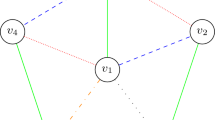Abstract
The aim of the paper was to propose a bounded-error quantum polynomial-time algorithm for the max-bisection and the min-bisection problems. The max-bisection and the min-bisection problems are fundamental NP-hard problems. Given a graph with even number of vertices, the aim of the max-bisection problem is to divide the vertices into two subsets of the same size to maximize the number of edges between the two subsets, while the aim of the min-bisection problem is to minimize the number of edges between the two subsets. The proposed algorithm runs in \(O(m^2)\) for a graph with m edges and in the worst case runs in \(O(n^4)\) for a dense graph with n vertices. The proposed algorithm targets a general graph by representing both problems as Boolean constraint satisfaction problems where the set of satisfied constraints are simultaneously maximized/minimized using a novel iterative partial negation and partial measurement technique. The algorithm is shown to achieve an arbitrary high probability of success of \(1-\epsilon \) for small \(\epsilon >0\) using a polynomial space resources.





Similar content being viewed by others
References
Armbruster, M.: Branch-and-Cut for a Semidefinite Relaxation of Large-Scale Minimum Bisection Problems. Ph.D. thesis, Technische Universitt Chemnitz (2007)
Armbruster, M., Fgenschuh, M., Helmberg, C., Martin, A.: A comparative study of linear and semidefinite branch-and-cut methods for solving the minimum graph bisection problem. In: Proceedings ofthe Conference on Integer Programming and Combinatorial Optimization (IPCO), LNCS, vol. 5035, pp. 112–124, (2008)
Bazgan, C., Karpinski, M.: On the complexity of global constraint satisfaction. In: Proceeding of 16th Annual International Symposium on Algorithms and Computation, vol. LNCS 3827, Springer, pp. 624–633 (2005)
Bazgan, C.: Paradigms of Combinatorial Optimization: Problems and New Approaches. In: Paschos, V.T. (ed) (Chapter 1: Optimal satisfiability), vol. 2, p. 25, Wiley-ISTE, (2010)
Bhatt, S.N., Leighton, F.T.: A framework for solving VLSI graph layout problems. J. Comput. Syst. Sci. 28(2), 300–343 (1984)
Delling, D., Goldberg, A.V., Razenshteyn, I., Werneck, R.F.: Graph partitioning with natural cuts. In: IEEE, Proceedings of the IEEE International Parallel and Distributed Processing Symposium (IPDPS), pp. 1135–1146 (2011)
Delling, D., Werneck, R.F.: Faster customization of road networks. In: Proceedings of the International Symposium on Experimental Algorithms (SEA). LNCS, vol. 7933, pp. 30–42. Springer, Berlin (2013)
Delling, D., Fleischman, D., Goldberg, A.V., Razenshteyn, I., Werneck, R.F.: An exact combinatorial algorithm for minimum graph bisection. Math. Program. (2014). doi:10.1007/s10107-014-0811-z
Josep Daza, J., Kamiskib, M.: MAX-CUT and MAX-BISECTION are NP-hard on unit disk graphs. Theor. Comput. Sci. 377(13), 271–276 (2007)
Feige, U., Langberg, M.: The RPR\(^2\) rounding technique for semidefinite programs. J. Algorithms 60, 1–23 (2006)
Feldmann, A.E., Widmayer, P.: An \(O(n^4)\) time algorithm to compute the bisection width of solid grid graphs. In: Proceedings of the European Symposium on Algorithms (ESA), LNCS, vol. 6942, pp. 143–154, Springer, (2011)
Guruswami, V., Makarychev, Y., Raghavendra, P., Steurer, D., Zhou, Y.: Finding almost-perfect graph bisections. In: Proceedings of ICS, pp. 321–337 (2011)
Garey, M.R., Johnson, D.S.: Computers and Intractability. A Guide to the Theory of NP-Completeness. W. H. Freeman and Company, London (1979)
Garey, M.R., Johnson, D.S., Stockmeyer, L.J.: Some simplified NP-complete graph problems. Theor. Comput. Sci. 1, 237–267 (1976)
Grover, L.K.: Quantum mechanics helps in searching for a needle in a haystack. Phys. Rev. Lett. 79, 325 (1997)
Hager, W.W., Phan, D.T., Zhang, H.: An exact algorithm for graph partitioning. Math. Program. 137, 531–556 (2013)
Hendrickson, B., Leland, R.: An improved spectral graph partitioning algorithm for mapping parallel computations. SIAM J. Sci. Comput. 16(2), 452–469 (1995)
Hein, M., Bhler, T.: An inverse power method for nonlinear eigen problems with applications in 1-spectral clustering and sparse PCA. In: Proceedings Advances in Neural Information Processing Systems (NIPS), pp. 847–855 (2010)
Høyer, P.: Arbitrary phases in quantum amplitude amplification. Phys. Rev. A 62, 52304 (2000)
Jansen, K., Karpinski, M., Lingas, A., Seidel, E.: Polynomial time approximation schemes for MAX-BISECTION on planar and geometric graphs. SIAM J. Comput. 35, 110–119 (2005)
Johnson, E., Mehrotra, A., Nemhauser, G.: Min-cut clustering. Math. Program. 62, 133–152 (1993)
Kwatra, V., Schdl, A., Essa, I., Turk, G., Bobick, A.: Graph cut textures: image and video synthesis using graph cuts. ACM Trans. Graph. 22, 277–286 (2003)
Land, A.H., Doig, A.G.: An automatic method of solving discrete programming problems. Econometrica 28(3), 497–520 (1960)
Lipton, R.J., Tarjan, R.: Applications of a planar separator theorem. SIAM J. Comput. 9, 615–627 (1980)
Malewicz, G., Austern, M.H., Bik, A.J., Dehnert, J.C., Horn, I., Leiser, N., Czajkowski, G.: Pregel, a system for large-scale graph processing. In: PODC, p. 6. ACM, (2009)
Meyerhenke, H., Monien, B., Sauerwald, T.: A new diffusion-based multilevel algorithm for computing graph partitions. J Parallel Distrib. Comput. 69(9), 750–761 (2009)
Rcke, H.: Optimal hierarchical decompositions for congestion minimization in networks. In: Proceedings of the ACM Symposium on Theory of Computing (STOC), pp. 255–263. ACM Press, New York (2008)
Raghavendra, P., Tan, N.: Approximating CSPs with global cardinality constraints using SDP hierarchies. In: Proceedings of SODA, pp. 373–387 (2012)
Rivlin, T.J.: Chebyshev Polynomials. Wiley, New York (1990)
Shi, J., Malik, J.: Normalized cuts and image segmentation. IEEE Trans. Pattern Anal. Mach. Intell. 22(8), 888–905 (2000)
Sanders, P., Schulz, C.: Distributed evolutionary graph partitioning. In: Proceedings of the Algorithm Engineering and Experiments (ALENEX), pp. 16–29. SIAM (2012)
Sanders, P., Schulz, C.: Think locally, act globally: highly balanced graph partitioning. In: Proceedings of the International Symposium on Experimental Algorithms (SEA). LNCS, vol. 7933, pp. 164–175. Springer, Berlin (2013)
Xu, Z., Du, D., Xu, D.: Improved approximation algorithms for the max-bisection and the disjoint 2-catalog segmentation problems. J. Comb. Optim. 27(2), 315–327 (2014)
Younes, A., Rowe, J., Miller, J.: Enhanced quantum searching via entanglement and partial diffusion. Phys. D. 237(8), 1074–1078 (2007)
Younes, A.: Towards more reliable fixed phase quantum search algorithm. Appl. Math. Inf. Sci. 7(1), 93–98 (2013)
Author information
Authors and Affiliations
Corresponding author
Rights and permissions
About this article
Cite this article
Younes, A. A bounded-error quantum polynomial-time algorithm for two graph bisection problems. Quantum Inf Process 14, 3161–3177 (2015). https://doi.org/10.1007/s11128-015-1069-y
Received:
Accepted:
Published:
Issue Date:
DOI: https://doi.org/10.1007/s11128-015-1069-y




